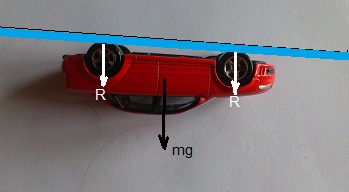Optional Practical: Loop the loop
Introduction
This practical is an investigation into the motion of a toy car travelling in a vertical circle (looping the loop) on a plastic track.

Theory
At the top of the track the car has potential energy, as it travels down this PE will be converted into kinetic energy which will be a maximum at the bottom of the slope. As the car climbs the loop this some of this KE will be converted back into PE but the car must retain enough KE so that it completes the circle (if it were to stop it would simply fall down).

So if energy is conserved mgh = mg2r + ½ mv2
To complete the circle the car must experience an unbalanced force that provides the centripetal force required. When at the top of the loop the forces are as shown below

so the centripetal force mv2/r = mg +2R
If the car goes faster the normal reaction is bigger. The minimum speed is when the centripetal force equals mg so R will be zero.
mv2/r = mg
So KE = ½ mv2 = ½ mgr
So at the slowest speed the total energy at the top will then be mg2r+½mgr = 2½mgr
So if energy is conserved mgh = 2½mgr
Method
By sending the car around different size loops at the minimum speed possible, conduct an experiment to test the relationship h=2.5r.
